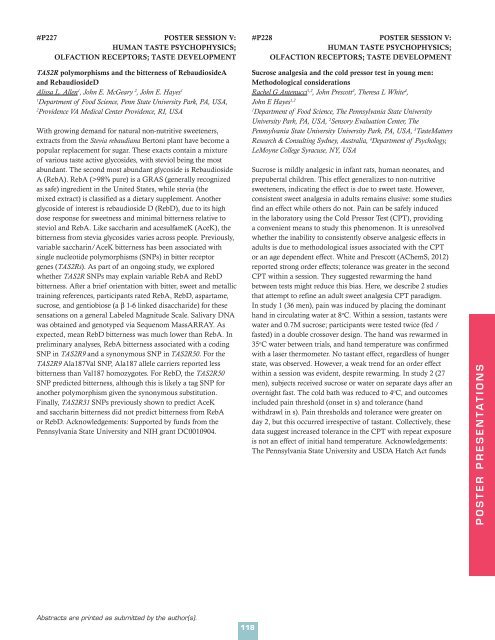Abstracts - Association for Chemoreception Sciences
Abstracts - Association for Chemoreception Sciences
Abstracts - Association for Chemoreception Sciences
Create successful ePaper yourself
Turn your PDF publications into a flip-book with our unique Google optimized e-Paper software.
#P227 POSTER SESSION V:<br />
HUMAN TASTE PSYCHOPHYSICS;<br />
OLFACTION RECEPTORS; TASTE DEVELOPMENT<br />
#P228 POSTER SESSION V:<br />
HUMAN TASTE PSYCHOPHYSICS;<br />
OLFACTION RECEPTORS; TASTE DEVELOPMENT<br />
TAS2R polymorphisms and the bitterness of RebaudiosideA<br />
and RebaudiosideD<br />
Alissa L. Allen 1 , John E. McGeary 2 , John E. Hayes 1<br />
1<br />
Department of Food Science, Penn State University Park, PA, USA,<br />
2<br />
Providence VA Medical Center Providence, RI, USA<br />
With growing demand <strong>for</strong> natural non-nutritive sweeteners,<br />
extracts from the Stevia rebaudiana Bertoni plant have become a<br />
popular replacement <strong>for</strong> sugar. These exacts contain a mixture<br />
of various taste active glycosides, with steviol being the most<br />
abundant. The second most abundant glycoside is Rebaudioside<br />
A (RebA). RebA (>98% pure) is a GRAS (generally recognized<br />
as safe) ingredient in the United States, while stevia (the<br />
mixed extract) is classified as a dietary supplement. Another<br />
glycoside of interest is rebaudioside D (RebD), due to its high<br />
dose response <strong>for</strong> sweetness and minimal bitterness relative to<br />
steviol and RebA. Like saccharin and acesulfameK (AceK), the<br />
bitterness from stevia glycosides varies across people. Previously,<br />
variable saccharin/AceK bitterness has been associated with<br />
single nucleotide polymorphisms (SNPs) in bitter receptor<br />
genes (TAS2Rs). As part of an ongoing study, we explored<br />
whether TAS2R SNPs may explain variable RebA and RebD<br />
bitterness. After a brief orientation with bitter, sweet and metallic<br />
training references, participants rated RebA, RebD, aspartame,<br />
sucrose, and gentiobiose (a b 1-6 linked disaccharide) <strong>for</strong> these<br />
sensations on a general Labeled Magnitude Scale. Salivary DNA<br />
was obtained and genotyped via Sequenom MassARRAY. As<br />
expected, mean RebD bitterness was much lower than RebA. In<br />
preliminary analyses, RebA bitterness associated with a coding<br />
SNP in TAS2R9 and a synonymous SNP in TAS2R50. For the<br />
TAS2R9 Ala187Val SNP, Ala187 allele carriers reported less<br />
bitterness than Val187 homozygotes. For RebD, the TAS2R50<br />
SNP predicted bitterness, although this is likely a tag SNP <strong>for</strong><br />
another polymorphism given the synonymous substitution.<br />
Finally, TAS2R31 SNPs previously shown to predict AceK<br />
and saccharin bitterness did not predict bitterness from RebA<br />
or RebD. Acknowledgements: Supported by funds from the<br />
Pennsylvania State University and NIH grant DC0010904.<br />
Sucrose analgesia and the cold pressor test in young men:<br />
Methodological considerations<br />
Rachel G Antenucci 1,2 , John Prescott 3 , Theresa L White 4 ,<br />
John E Hayes 1,2<br />
1<br />
Department of Food Science, The Pennsylvania State University<br />
University Park, PA, USA, 2 Sensory Evaluation Center, The<br />
Pennsylvania State University University Park, PA, USA, 3 TasteMatters<br />
Research & Consulting Sydney, Australia, 4 Department of Psychology,<br />
LeMoyne College Syracuse, NY, USA<br />
Sucrose is mildly analgesic in infant rats, human neonates, and<br />
prepubertal children. This effect generalizes to non-nutritive<br />
sweeteners, indicating the effect is due to sweet taste. However,<br />
consistent sweet analgesia in adults remains elusive: some studies<br />
find an effect while others do not. Pain can be safely induced<br />
in the laboratory using the Cold Pressor Test (CPT), providing<br />
a convenient means to study this phenomenon. It is unresolved<br />
whether the inability to consistently observe analgesic effects in<br />
adults is due to methodological issues associated with the CPT<br />
or an age dependent effect. White and Prescott (AChemS, 2012)<br />
reported strong order effects; tolerance was greater in the second<br />
CPT within a session. They suggested rewarming the hand<br />
between tests might reduce this bias. Here, we describe 2 studies<br />
that attempt to refine an adult sweet analgesia CPT paradigm.<br />
In study 1 (36 men), pain was induced by placing the dominant<br />
hand in circulating water at 8 o C. Within a session, tastants were<br />
water and 0.7M sucrose; participants were tested twice (fed /<br />
fasted) in a double crossover design. The hand was rewarmed in<br />
35 o C water between trials, and hand temperature was confirmed<br />
with a laser thermometer. No tastant effect, regardless of hunger<br />
state, was observed. However, a weak trend <strong>for</strong> an order effect<br />
within a session was evident, despite rewarming. In study 2 (27<br />
men), subjects received sucrose or water on separate days after an<br />
overnight fast. The cold bath was reduced to 4 o C, and outcomes<br />
included pain threshold (onset in s) and tolerance (hand<br />
withdrawl in s). Pain thresholds and tolerance were greater on<br />
day 2, but this occurred irrespective of tastant. Collectively, these<br />
data suggest increased tolerance in the CPT with repeat exposure<br />
is not an effect of initial hand temperature. Acknowledgements:<br />
The Pennsylvania State University and USDA Hatch Act funds<br />
POSTER PRESENTATIONS<br />
<strong>Abstracts</strong> are printed as submitted by the author(s).<br />
118
















